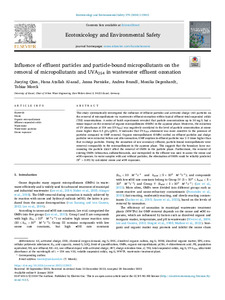| dc.date.accessioned | 2024-03-06T08:21:18Z | |
| dc.date.available | 2024-03-06T08:21:18Z | |
| dc.date.issued | 2024-01-09 | |
| dc.identifier | doi:10.17170/kobra-202403069727 | |
| dc.identifier.uri | http://hdl.handle.net/123456789/15534 | |
| dc.description.sponsorship | Gefördert durch den Publikationsfonds der Universität Kassel | |
| dc.language.iso | eng | |
| dc.rights | Attribution-NonCommercial-NoDerivatives 4.0 International | * |
| dc.rights.uri | http://creativecommons.org/licenses/by-nc-nd/4.0/ | * |
| dc.subject | Ozone | eng |
| dc.subject | Organic micropollutants | eng |
| dc.subject | Effluent suspended solids | eng |
| dc.subject | Wastewater | eng |
| dc.subject | Wastewater particles | eng |
| dc.subject | Ozone exposure | eng |
| dc.subject.ddc | 620 | |
| dc.title | Influence of effluent particles and particle-bound micropollutants on the removal of micropollutants and UVA₂₅₄ in wastewater effluent ozonation | eng |
| dc.type | Aufsatz | |
| dcterms.abstract | This study systematically investigated the influence of effluent particles and activated sludge (AS) particles on the removal of micropollutants via wastewater effluent ozonation within typical effluent total suspended solids (TSS) concentrations. A series of batch experiments revealed that particle concentrations up to 30 mg/L had a minor impact on the removal of organic micropollutants (OMPs) in the aqueous phase. Moreover, the reduction of UV absorbance at 254 nm (UVA₂₅₄) was negatively correlated to the level of particle concentration at ozone doses higher than 0.5 gO₃/gDOC. It indicates that UVA₂₅₄ abatement was more sensitive to the presence of particles compared to OMP removal. Organic micropollutants (OMPs) sorbed on effluent particles and sludge particles were extracted before and after ozonation. OMP sorption in effluent particles was 2–5 times higher than that in sludge particles. During the ozonation of raw secondary effluent, particle-bound micropollutants were removed comparably to the micropollutants in the aqueous phase. This suggests that the boundary layer surrounding the particle didn’t affect the removal of OMPs in the particle phase. Furthermore, the removal of existing OMPs (irbesartan, sulfamethoxazole, and metoprolol) in the effluent was used to assess the ozone and •OH exposure. In water samples with and without particles, the elimination of OMPs could be reliably predicted (R² > 0.95) by calculated ozone and •OH exposures. | eng |
| dcterms.accessRights | open access | |
| dcterms.creator | Quian, Jueying | |
| dcterms.creator | Atallah Al-asad, Hana | |
| dcterms.creator | Parniske, Janna | |
| dcterms.creator | Brandl, Andrea | |
| dcterms.creator | Degenhardt, Monika | |
| dcterms.creator | Morck, Tobias | |
| dcterms.extent | 9 Seiten | |
| dc.relation.doi | doi:10.1016/j.ecoenv.2023.115915 | |
| dc.subject.swd | Ozon | |
| dc.subject.swd | Abwasser | ger |
| dc.subject.swd | Mikroverunreinigung | ger |
| dc.subject.swd | Belebtschlamm | ger |
| dc.type.version | publishedVersion | |
| dcterms.source.identifier | eissn:1090-2414 | |
| dcterms.source.journal | Ecotoxicology and Environmental Safety | eng |
| dcterms.source.volume | Volume 270 | |
| kup.iskup | false | |
| dcterms.source.articlenumber | 115915 | |
| ubks.epflicht | true | |


